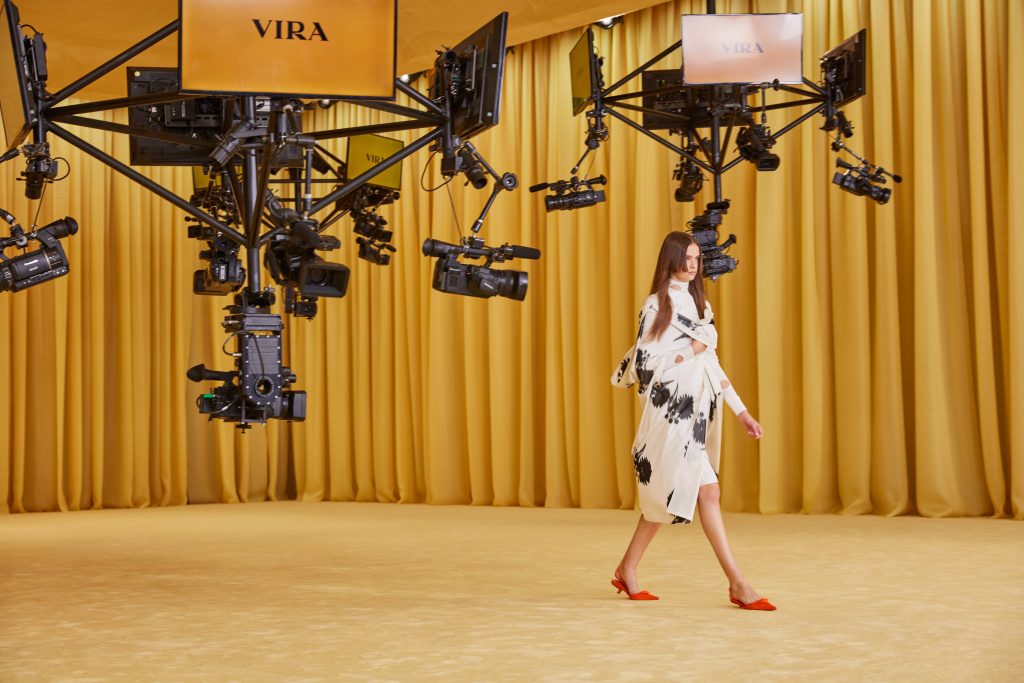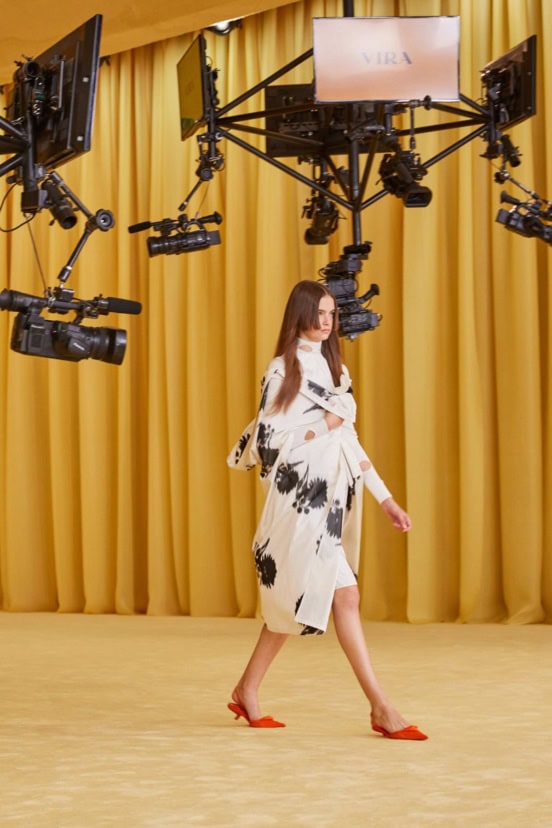Review of first joint runway show of Raf Simons and Miuccia Prada – Prada Spring 2021 Fashion Show
The New Era – Two Minds for One Wardrobe
By Long Nguyen
“It came out kind of spontaneously and all of a sudden it really happened,” Prada said in response to a question about when she thought of the idea of asking Raf Simons to join her as co-creative director.
This extraordinary post-show conversation was unique in many ways as Miuccia Prada and Raf Simons actually answered questions submitted by the public in an unprecedented open live session. But then again, this is a historic moment in fashion, a major moment of transformation that was unimaginable even six months ago when the announcement was made of the co-creative director with equal responsibilities over the direction of not just the collection and the brand but perhaps signaling a way for many fashion companies to move forward in significant ways in the future.
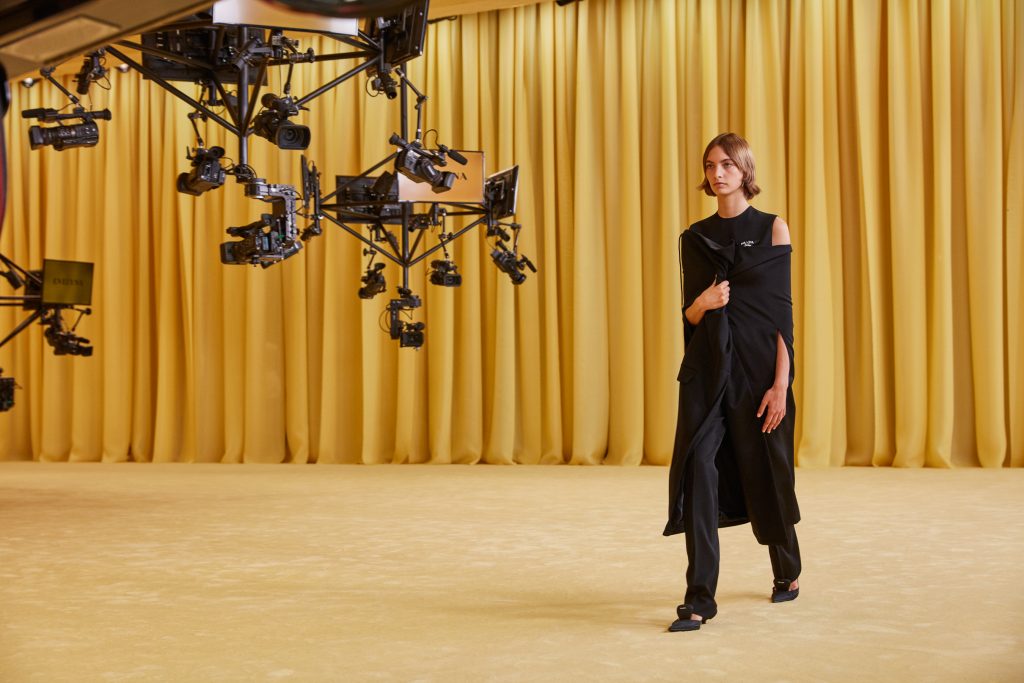
“I think it never to me that this could have ever happened,” Simons said in recounting the long period of time he had known Prada and especially after he was chose to lead Jil Sander in 2005, then a Prada Group Company, and he first foray into womenswear. “We have always been very interested in each other’s work.” “It will be more interesting to have time to think more and to discuss more,” Prada said.
New is a nightmare for every single designer as it is always for me. But I think it is not so relevant anymore because now everyone has to express the deep thought of a person, of a brand. So the new just for the sake of doing new is not important for work.
– Miuccia Prada, responding a question about the necessity for newness
“Fashion, in general, always hopes for the new but when you are in it for a long time, let’s say a few decades, it is important to refresh your own body of work,” Simons responded. “Our present is done with our past,” Prada agreed.
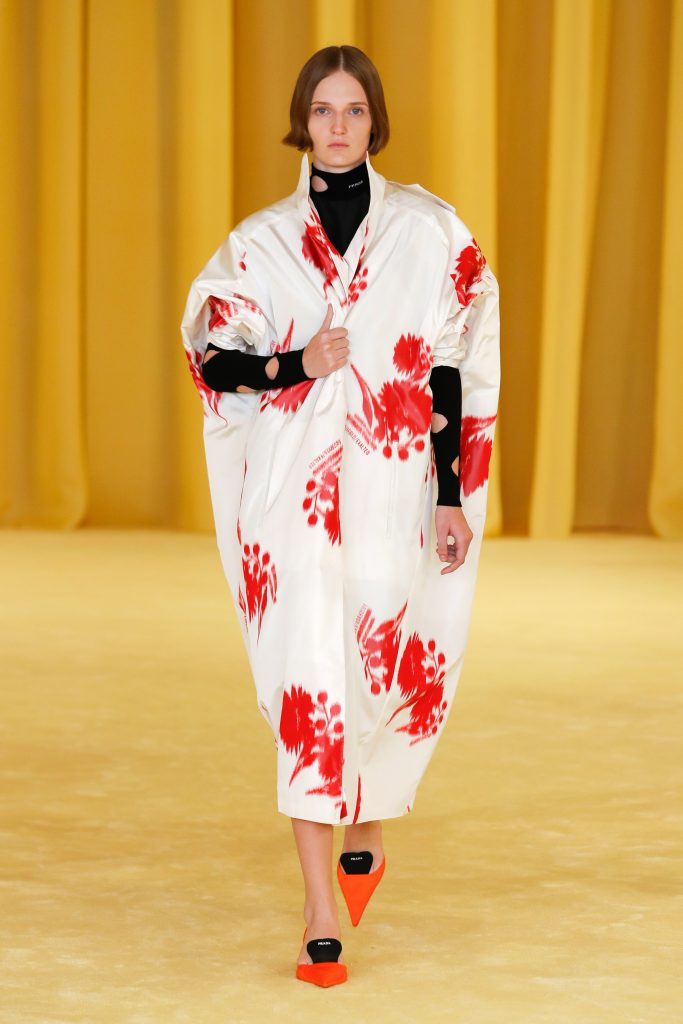
It is therefore critical to look at Prada and Simons’ body of work and here perhaps it is illuminating to go back to the mid 1990’s and see how two of their early collections shown at about the same time frame contained the seed of their thinking and how they will change the idea of ‘Prada-ness’ or what both designers called ‘uniform’ not in just clothes but in a “community, a visual representation of identity, of shared and embraced values, a way of thinking.”
I have always seen Prada as a community that has a very specific, attitude, intellect. You can’t define what it is but you feel it’s there.
– Raf Simons
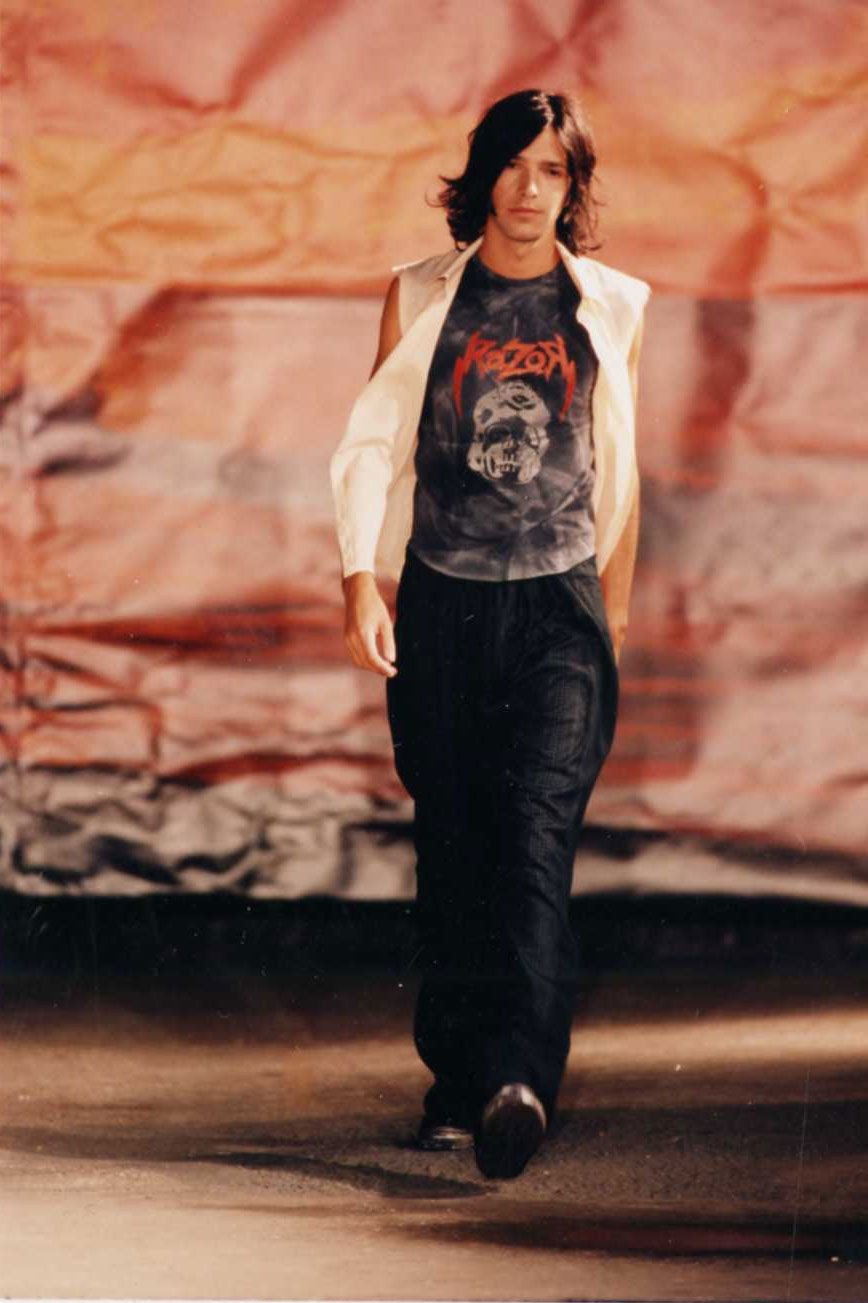
In one of Simons’s most important shows of his early career ‘Black Palms’ for spring 1998, he proposed black pleated classic wool pants and slim single-breasted suits – basically honing a traditional sartorial approach updated for a generation about to confront fashion in more conscious manners. Simons transported his casting of young kids on a bus from his hometown Antwerp to Paris for that show – they were also the audience and the future consumer he aimed to speak to at that time and they were at an age where they were about to question the content of their wardrobe. Perhaps these kids were able to make choices for the first time themselves what to wear and Simons deeply understood this process. His oeuvre craft as a fashion show in a garage instead of a music album or a rave party was to convince them that a tailored slim suit was fine as long as he can create an ideology around them that was familiar to youth culture.
In the same way, Prada confronted the same problem. Prada was someone all too settled about accepting traditional societal tenets and decorum at face value as a progressive woman but at the same time, she wasn’t someone whose thinking also consisted of radical ideas. Prada was making expensive products and she had to convince the wealthier set to open their purses. But at the same time, she had to make products that could be sold to new consumers who might reject being labeled ‘traditional’.
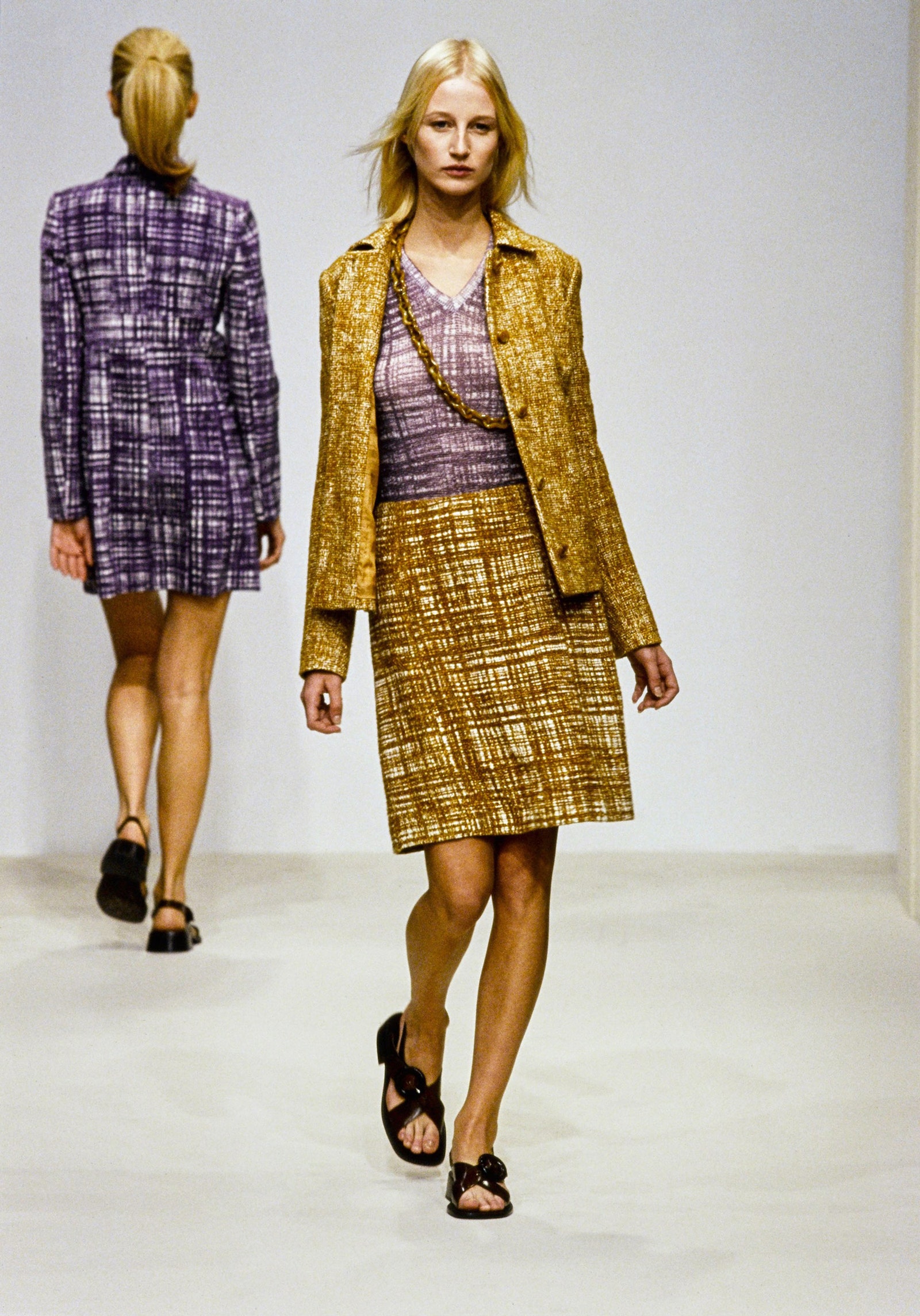
Prada’s solution was her Spring 1996 held in Milano in October 1995, a collection of wild mixing of prints in intoxicating ways that almost make the superbly made clothes unattractive at first but opened the route to both the traditional and the avant-garde consumers to embrace the Prada brand. New artists and older bankers could now embrace the brand. Both the Prada route to sell the expensive un-bourgeois clothes back to the Borghesia and the way Simons was trying to sell his slim black suits to ravers and skaters followed a similar same path. A black and orange print sweat top and long below the knee skirt in this spring 2021 show recalled the prints shown twenty-five years ago.
Clothes that have less of an association with stereotypes, less defined end-users – in Prada’s case the archetypes of the bourgeoisie (or its Milanese version Borghesia) and in Simon’s case the notion that his young audience would simply reject any encroachment of traditional impositions on their wardrobe choices. Both Prada and Simons had to address this dichotomy in making their clothes just with enough traditions but not too much and with just enough of innovation but then again not too much either.
I had the chance to see both of these shows in Milano and in Paris at the time. These were shows that strike conversations, discussions about their implications on fashion and on society. I sense that both Prada and Simons share a similar path, similar aesthetics, or in their affinities towards a certain aesthetic and taste in fashion, culture, and arts albeit both took different routes to arrive here today. Both designers shattered the social and cultural associations of the clothes in their own methodology and created a symbolism of fashion first before selling the products. Prada’s clothes since the mid-1990s offered her view of the world at large and specifically her view of fashion, of women and their status in society and their relationship with each other, and how the sexes relate to each other.
But putting the luxury and crafts of the products aside, Prada clothes never really exude that sense of high-class snobbery but rather encompassed on a more prominent working-class chic if that’s even the right word, maybe working-class art or high tech executive chic. The skirt remains the central item in Prada’s work throughout the years in all its manifestations and makings enough to mount an exhibit in 2004 titled ‘Waist Down’ which was all about skirts.

If there is one item of clothing that is identifiable as Prada, it is the skirt. The skirt is the foundation of the Prada wardrobe – the skirt is where everything is built from.
It is an ultra-feminine collection where all kinds of skirts – long or short, below or above the knee or even ankle length become the base where the jackets, the coats, the sweaters, and everything else is built around. These skirts showed off the new shoes each season and the new bags the models carried next to their skirt outfits. Even the dress and there have been so many Prada dresses over all these years can be considered as an all in one one-piece skirt. Consumers know when they see a Prada skirt.
A Prada women show had always opened with a skirt look. At her last solo showing in July during the men’s presentation, Prada opened her resort 2021 with a model in a navy wool single breast jacket and a knee-length skirt folded in the front and a crisp men’s white cotton shirt. It was the look that epitomized the Prada ethos and one she chose to close her solo showing.
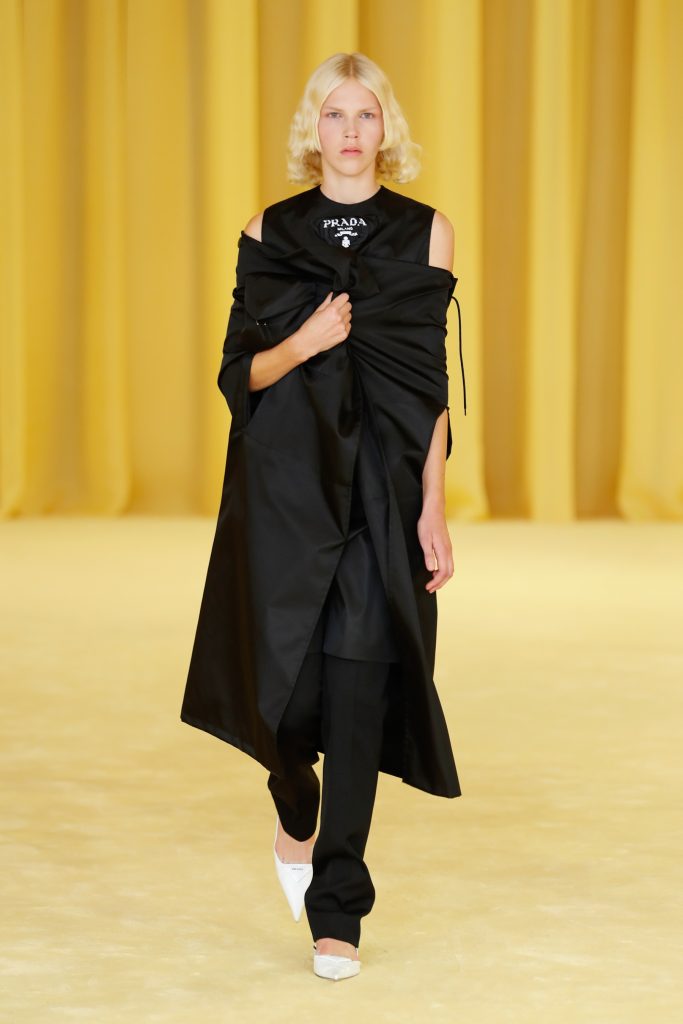
But today was an exception to the rule. A model opened wearing with a sleeveless nylon coat, a black cotton dress with the triangle logo at the front, and tailored mannish black cigarette pants under the dress as she walked a set closed with yellow curtains and a set of automatically operated cameras focusing on her clothes with close-ups of her face. Pants? Pants have always been a Simons thing – if you look black at his Spring 1998 Black Palms shows he had a bunch of naked torso models just wearing different versions of his black gabardine pants in solid or subtle pinstripe and slim fitted or hippie flared shapes. His opening look for the fall-winter 2012 Dior haute couture show was a new version of the Bar but as a slim cut pantsuit. Here, dress and pants merged into a single look.
Perhaps one of the big questions going into today’s show was whether Simons had to work within the confines of the Prada language or was he able to free contribute to the discourse of fashion and to advance this discourse in his own ways. From what I saw in the show clearly he does not.
“It is easier for me because I can share more than I used to share, but maybe it takes more energy because you are not alone. Sharing is more interesting,” Prada said. “Decision making for me is strengthened when I know that Miuccia also likes very much what I like. So when I am convinced my decision is strengthened when I know that she is convinced and the other way around,” Simons said. “It’s a beginning and there is time for subtraction and addition and that’s the beauty of it as we just started working together,” Prada responded to a question about what will be added or subtracted from the collections. “This show is definitely about both and we do not want to create for ourselves a specific way of working that would lead to either one of these two but we want to have the freedom that maybe we would do a collection which is very much everything that Miuccia says and I feel very related to it and not literally the two worlds sliding together and maybe also the other way around. It is very important to keep the freedom of how we perceive our own way of working” Simons explained parts of the creative process.
“It’s a beginning and there is time for subtraction and addition and that’s the beauty of it as we just started working together,” Prada said of the pared-down slim silhouette collection devoid of any excess or ornamentations. The entire collection consists of several basic wardrobe garments – coat, raincoats, skirts, pants, stretch tee shirts, sweatshirts, and dresses. Perhaps it’s in a way a response to the current times but maybe it is also how both designers want to start with just the identifiable simplicity to wipe the slate clean for a fresh start of a new era.
The uniforms here are not metaphorical. The clothes looked fresh and felt renewed and ‘timeless’ as Simons mentioned.
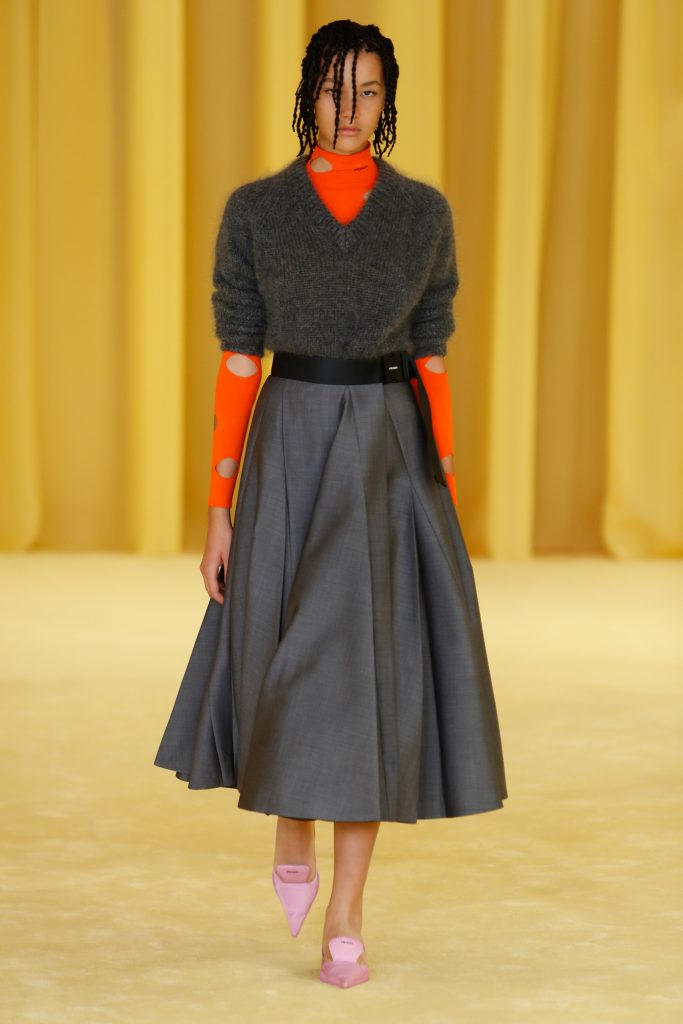
In fact, Simons influence permeated silently and loudly throughout the collection – in the first section of the show in the manner of the models holding on to their coats, in all those cigarette cut wool pants paired with tee shirts and coats, in the series of slightly oversized ‘sweatshirts’ worn with those long fold skirts. And you can clearly see Prada’s direct hand in those high pleats wool long flowing skirts, one worn with a gray Shetland sweater and an orange mock neck undershirt with round cut out holes.
Both Prada and Simons had long worked with artists resulting in different products made – this time it was Simons who chose the artist to decorate some of the dresses, coats, and skirts. The Belgian artist Peter de Porter who Simons had worked with over the years on visual quotes added the words like ABSORB/EXALTED, GLOWING, PROLOGUE, FICTION ALIVE, LIVE FICTION, SHARING OF MIRAGE, SIGNAUX, WE ARE ABSORBED, QUICK!!, CONTINUATION – words printed alongside Prada’s floral archival prints that signified perhaps our current anxiety – on white silk tunic, re-nylon white raincoats, dresses.
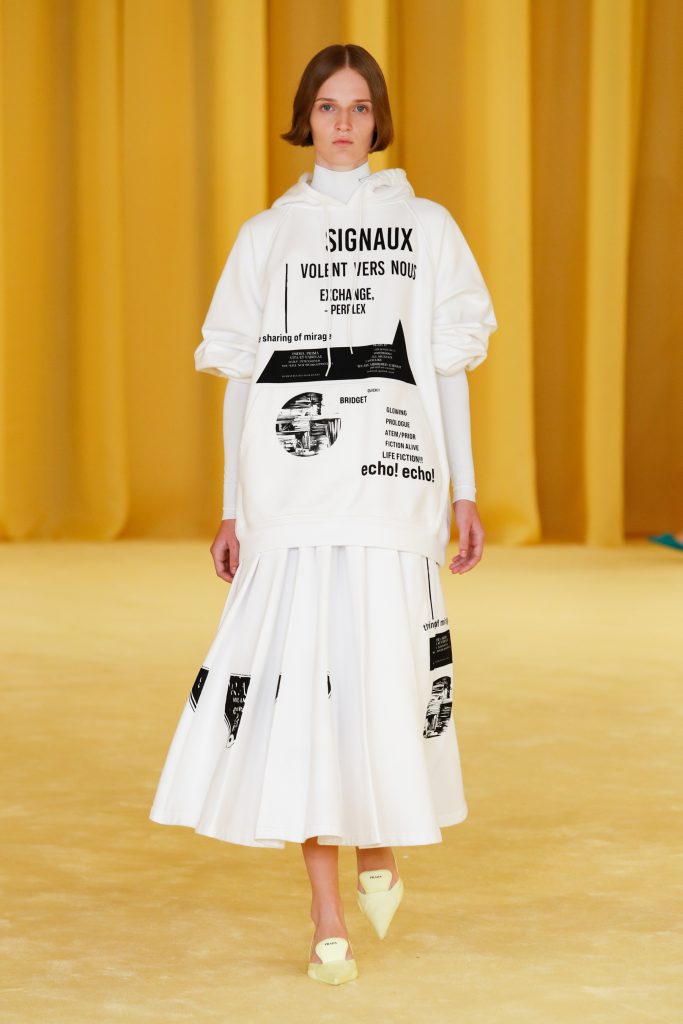
The loose white hooded short sleeve sweatshirt paired with the long flare skirt is a perfect example of this fusion, a symbiosis of clothes, aesthetics and arts.
It was strange to witness the ubiquity of the Prada triangular logo in the beginning segment of the show as if it was imperative to confirm to the consumer that this was indeed from the brand. Prada is not a brand that historically pursued marketing its logo unlike brands like Louis Vuitton, Dior, or Fendi.
The Prada logo is never marketed all over any products in a way the Louis Vuitton monogram or double FF logos are. But consumers recognized the nylon products, the fine feel of a sweater with fine trims, the jackets, coats, linings, and shoes. Here, both Prada and Simons pointed to their common departure point of a uniform and as a point of commonality and identification rather than one of logo display.

Prada clothes are driven by the sharp senses of their own feelings and where things are in the world today rather than by any formula and above all not driven by marketing pejoratives. This is another reason why choosing a collaborator who is unconcern about the heavy domination of marketing and spreadsheets is critical to preserve the Prada aesthetic in theory and in practice. For Simons, it is finally finding a house where he can be comfortable with his art approach to fashion. Oh, wait what menswear will look like?
Prada mentioned sustainability as one of the goals of the brand. The launch last year of the Re-Nylon Econyl project with the intention of using only repurpose nylon in the manufacturing process served not only to reduce waste and pollution but also aligned the Prada company values with the values of young people globally today.
What was truly great in the show was how smoothly ideas from two creative people can be merged and can be seen separately in this collection. It will no longer be the Simons pants or the Prada skirts but it will be an outfit that has both ideas resulting in looks so refreshingly effortless, with little fuss or pretensions worn by a set of models who have never done a Prada show before now.
To put this collaboration in the context of literature, let’s imagine the theoretical possibility of two writers collaborating on a novel. What about imagining the French writers and philosophers Jean-Paul Sartre (famous for his first novel La nausée written in 1939) and Simone de Beauvoir (famous for her treatise on women La deuxième sexe written in 1939) collaborating on a joint novel written together by both writers. It would not be such an anomaly to imagine this Sartre-de Beauvoir novel as a possibility. Now, in fashion, we actually have a Prada-Simons collection to converse and to wear.
